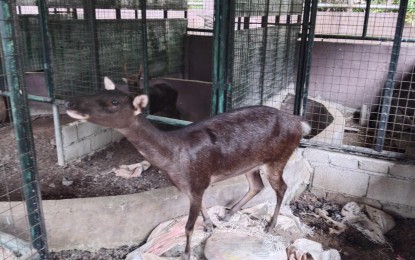
ENDANGERED. A Philippine deer inside the Eastern Visayas Regional Wildlife and Rescue Center in Palo, Leyte. The center took care of 24 rescued animals during the first quarter of 2024. (PNA photo by Sarwell Meniano)
TACLOBAN CITY – The Eastern Visayas Regional Wildlife and Rescue Center (RWRC) of the Department of Environment and Natural Resources (DENR) took care of 24 rescued animals in the first quarter of 2024.
Among them are six for rehabilitation, rescued in March, and four released to the wild in February.
The four wild animals released in Lake Danao are one reticulated python, two white-eared doves, and one brown booby seabird.
“Rescued wild animals are usually released in Lake Danao in Ormoc City and Mahagnao Natural Park in Burauen, Leyte. These are protected areas where the animals can thrive and start anew without disturbance of human activities,” DENR-RWRC chief Rodrigo Marquez said in an interview Tuesday.
The DENR also received a rescued monitor lizard, a brown booby, two white-eared brown doves, and two reticulated pythons turned over by residents during the first quarter.
The rest of the animals have been under the care of RWRC for several years since they are tame or have no ability to hunt food in the wild.
“If we release them into the wild, people will easily catch them since they don’t know how to avoid predators. We are sure they will get close to populated areas,” Marquez said.
Among these domesticated animals are a male deer, a female deer, and several monkeys.
“We tried to release monkeys into the wild, but they climbed houses and steal food because they are no longer used to hunt food due to prolonged domestication," Marquez added.
The number of days of rehabilitation at the RWRC depends on the condition of the animal upon turnover or rescue. If the animal needs immediate treatment, they are attended to by an on-call veterinarian.
Currently, there are more than 20 cages designed for specific species, such as snakes, birds, civet cats, and monkeys.
The DENR-RWRC provides care to injured, sick, orphaned, and rescued domesticated wildlife with the goal of releasing them back into their natural habitat once they've recovered. (With reports from Del Sevilla, OJT/PNA)
